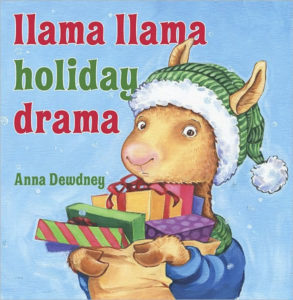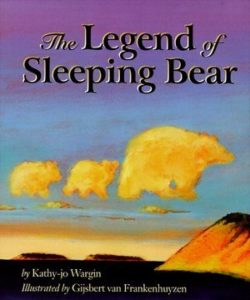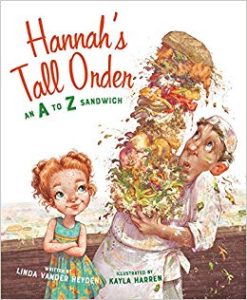 The September 2020 Insider Interview is with…Sarah Rockett!
The September 2020 Insider Interview is with…Sarah Rockett!
She’s an Editor for Sleeping Bear Press as well as for Cherry Lake Publishing and 45th Parallel school and library imprints. OPB knows all about her work because we’ve recently covered books she edited: Winged Wonders: Solving the Monarch Migration Mystery, Nature’s Friend: The Gwen Frostic Story, and The Boy Who Grew a Forest. (Yep—we enjoy Sleeping Bear books here at OPB!)
She’s a Michigan person through and through, and these days, she lives outside Ann Arbor with a husband, a son, and a cocker spaniel. And a whole bunch of books, one imagines!
Let’s get to the interview to learn a bit more about all Sarah does!
RVC: You earned a degree in journalism from Boston University. What turned you from a life of newspaper/magazine writing toward the editorial side of things?
SR: News and magazine writing ultimately felt too fast paced for me. I found that I enjoyed spending more time on the text I was working with—to really be careful with language and more creative. I didn’t love the pressure of a news cycle.
RVC: What was your favorite piece of journalism you ever wrote?
SR: I did the Semester at Sea study abroad program in college and ended up writing a handful of pieces for my hometown newspaper while I was traveling. They were writer-at-large type stories—and rightfully buried in the paper—but they were a lot of fun to research and write.
RVC: Sounds like a nautically cool time! I wish I’d investigated such interesting off-campus experiences like that as an undergrad.
Now, working in NY publishing is the dream for many. What were some of the unexpected benefits/joys of being part of it?
 SR: The big budgets were great. Knowing you had some frontlist “season makers” like a new Llama Llama book by Anna Dewdney or the latest John Green YA, as well as a really strong backlist with a good number of classics, meant we could take some additional risk with other projects. The publishing community in NYC was also really wonderful. I was always running into people from other companies—and it was really nice to talk with them about issues facing the industry and trends.
SR: The big budgets were great. Knowing you had some frontlist “season makers” like a new Llama Llama book by Anna Dewdney or the latest John Green YA, as well as a really strong backlist with a good number of classics, meant we could take some additional risk with other projects. The publishing community in NYC was also really wonderful. I was always running into people from other companies—and it was really nice to talk with them about issues facing the industry and trends.
RVC: What was the biggest issue facing the industry at that time?
SR: When I was with Penguin, ebooks were just really taking off and it was so interesting to see how the industry was feeling out the best way to work with the technology. For adult books, the link to ebook is easy/obvious. But for children’s books, there are so many more issues around the benefits of books vs ebooks. Many ebook developers wanted to include a lot of interactive features and animations–which can be great, but when does it become a game or cartoon and no longer a book? I don’t think the industry (or consumers) have figured it out yet, but it was really interesting to be in the hub of publishing when the initial ebook frenzy started.
RVC: If you had to summarize the most important thing you’ve learned about editing books for children, what would it be?
SR: I think brevity and specificity are the two most important elements to creating wonderful picture books. There’s something magical about leaving space in the text for a child’s imagination. And if you’re keeping text really tight, you have to be sure each word is working really hard for you—it has to mean exactly what you want it to mean.
RVC: About seven years ago, you left NY publishing and worked as a freelance writer/project manager for ProQuest for a year.
SR: When I moved back to Michigan, there weren’t a lot of children’s publishing companies to work with. In fact, there’s exactly one in about a 500-mile radius—Sleeping Bear Press. Working freelance let me keep my skills fresh while I nudged the owner of Sleeping Bear about an informational interview and waited for a position to open.
 RVC: In 2013, you landed that coveted job. What were some of the differences between working at Sleeping Bear versus a large outfit like Puffin/Penguin Young Readers?
RVC: In 2013, you landed that coveted job. What were some of the differences between working at Sleeping Bear versus a large outfit like Puffin/Penguin Young Readers?
SR: I love working with a smaller company. The doors to the owner and publisher are always open for questions and advice. And I love that there aren’t a ton of steps to project approval. If I’m passionate about a title or project, I can generally make my case to the owner or acquisition group and then move forward. There aren’t a lot of corporate hoops to jump through—which I think allows the editors (and everyone) to be more creative.
RVC: Let’s talk submissions. I know you like timely hooks (which right now probably means diversity, social justice, environmentalism, etc.), but it strikes me that Sleeping Bear leans toward picture books well-suited to solid educational backmatter. Would you rather see a great-for-the-classroom book, or one that’s a total laugh-out-loud good time?
SR: I don’t think I can choose! I really love working on books that have something important to say—whether that’s a biography of someone previously overlooked in history or a story that encourages kids to reduce their plastic waste, etc.—but books that are just pure fun are a delight! Truly funny, laugh-out-loud books are so hard to write, so they can be few and far between.
RVC: How many submissions do you see in a month?
SR: Probably 50–100.
RVC: What percentage of those is agented?
SR: I would guess about 20 percent of those are agented or submitted directly from an author I have a relationship with—the rest come in via email submissions per the guidelines on our website.
RVC: Help us understand what Sleeping Bear is really all about. What three picture books really capture the representative spirit of your press’ aesthetic and creative philosophy?
 SR: The Legend of Sleeping Bear for its regional hook and unparalleled art. Memoirs of a Goldfish, which is funny and heartfelt. Winged Wonders: Solving the Monarch Migration Mystery, which is a great classroom title with really strong trade crossover—and the illustrations are just so lovely.
SR: The Legend of Sleeping Bear for its regional hook and unparalleled art. Memoirs of a Goldfish, which is funny and heartfelt. Winged Wonders: Solving the Monarch Migration Mystery, which is a great classroom title with really strong trade crossover—and the illustrations are just so lovely.
And I have to add A Boy Like You—a story with a really important social emotional message.
RVC: It’s interesting that you mention Memoirs of a Goldfish, because that’s how I learned about your press. I was at Book Expo America in NYC back in 2010 or so, and that book was a giveaway from your press. My kids enjoyed it so much that we eventually picked up the sequels–witness the photographic evidence (minus the Elf and Parrot ones, which my kids have hidden somewhere special, and they won’t share where)!
 SR: Oh gosh! I love coincidences like that!
SR: Oh gosh! I love coincidences like that!
RVC: In many ways the publishing world is a small one, and kids really latch onto their favorites.
Back to the regularly scheduled interview…I’ve heard that you appreciate when an author sells themselves in a pitch letter. But there’s the flip side, which is when a not-yet-debut author might say, “Hey, I’m going to be the next Jane Yolen, only faster!” What are some examples of how to manage the middle ground between self-promotion (the good version) versus SELF-PROMOTION (the icky version)?
SR: It’s important for editors to have the facts on our authors. So writing groups you’re involved with, social media platforms, relevant professional experience, existing school or conference presentations, etc. But authors should stay away from subjective and/or grandiose claims. If you/your story is as good as you think it is (i.e. “the next Where the Wild Things Are”), we’ll see it—don’t force it on editors.
RVC: Great advice. And speaking of advice, what do you say about art notes?
SR: In general, I strongly advise against them. A submitting author’s goal is to have the acquiring editor feel personally and passionately about their story. It’s hard to feel an attachment to a story if every other line the author is telling you what you’re seeing. The beauty of publishing a picture book is that everyone involved brings something to the project (author, editor, illustrator, and designer) that makes it stronger. Let editors have that moment to really be engaged in the story.
RVC: One final question for this part of the interview. Rumor has it that you’re a mega-fan of Gwen Frostic. Actual news or fake news?
SR: Yes! Love her. I grew up with her art and going to her studio in Northern Michigan—I even met her a couple time before she passed and I have a tattoo of one of her pieces!
When I received the submission for Nature’s Friend, I was SO floored!
RVC: Alrighty, it’s time for the Lightning Round! And that means the questions are zippy, the answers are zappy, and the fun is totally electrified. Are you ready?
SR: Let’s do it!
RVC: Which picture book character would you love to be for a day?
 SR: Hannah, from Hannah’s Tall Order. She’s got an appetite and knows what she wants.
SR: Hannah, from Hannah’s Tall Order. She’s got an appetite and knows what she wants.
RVC: Best place in Northern Michigan to get a cherry pie?
RVC: Pick a theme song for where your life is at right now.
SR: “You’ve Got a Friend” by James Taylor.
RVC: What’s your dream project?
SR: Something lyrical and important.
RVC: Favorite non-Sleeping-Bear picture book of 2020 (so far)?
 SR: Your Name Is a Song by Jamilah Thompkins-Bigelow.
SR: Your Name Is a Song by Jamilah Thompkins-Bigelow.
RVC: Three words that sum up what picture books mean to you?
SR: Growing little minds.
RVC: Thanks so much, Sarah! Next time I’m up in Ann Arbor, the Vernors ginger ale is on me!

